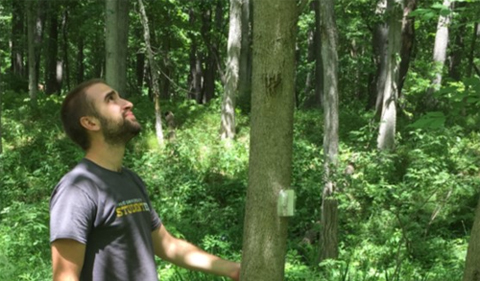
Jeremy Held
By Heather Willard, PACE Writer
The forest pest Emerald ash borer, which kills Ash trees, has been an issue in the United States since it was first detected in 2002, but Jeremy Held thinks there may be hope for the endemic trees.
He received a Provost Undergraduate Research Fund award in January 2016 to support his research on genetic diversity of an ash population that possibly may hold the key to resisting the borer.
Held, an Ohio University Honors Tutorial College senior majoring in Plant Biology, first became interested in ecological research while he was interning with U.S. Forest Service at Vinton Furnace Experimental Forest during 2015. He became interested in the research of Dr. Jennifer Koch, who studies possible resistance to the ash borer in a variety of ash trees.
Taking Samples Near Toledo
Field research for the experiment started in June, when Held went to Oak Openings Metropark and looked for resistant and susceptible populations.
“We found a population of green ash, which is a pretty common North American ash species, with a few healthy trees (in a population near Toledo), and they represented about 1 percent of the previous population,” Held said. “Some of the trees were essentially killed, but it was above ground mortality. They’re very susceptible but still holding on, barely. I can sample from them [because some individuals with aboveground mortality will stump sprout to produce new shoots]. So that’s my pre-(Emerald ash borer) pop. And then I sample from those trees that are still healthy, and that’s my post-(Emerald ash borer) pop. And I can compare to see the impact on genetic diversity.”
The borer is known for its unique focus on ash trees. The borer is thought to have found its way to the United States via shipping materials from Asia, and the larvae eat the phloem just under the bark of the tree where they are laid before maturing into an adult beetle.
“There are these galleries (paths) that the larvae make eating the phloem, which is the tissue that conducts nutrients throughout the tree. These galleries disrupt the flow of food throughout the tree, and that’s what eventually ends up killing the tree,” Held explained. Currently over 25 states are infested, and Held stated that hundreds of millions of trees have been affected.
Discovering ‘ Large Reservoir of Genetic Diversity’ Generates Optimism
Dr. Harvey Ballard, Associate Professor of Environmental & Plant Biology, mentored Held during his project. To compare genetic diversity of trees in the pre- and post-ash borer populations, Held accessed molecular markers called “microsatellites” that produce different fragment lengths through time in wild populations. Held worked in the lab extracting DNA, conducting polymerase chain reactions to examine length variants in a dozen microsatellite marker regions in each ash tree, and analyzing the data to discover the genetic diversity of the population before and after the ash borer infestation.
Currently, Held is completing his initial analyses, but the emerging story clearly points to a large reservoir of genetic diversity being harbored in the dramatically reduced remnant population. This unanticipated finding, reflecting the broad wind-pollinated breeding system of the ash, gives him optimism that the devastation of the emerald ash borer may not have the last word on survival of ash species in North American forests. He hopes that his data will be useful with results of other studies to guide the U.S. Forest Service in managing sustainable populations of ash trees.
“Being involved in all aspects of a project has been really tremendous,” Held reflected. “Most undergraduate researchers only work on a certain part of a project, but seeing it through from start to finish is really incredible.”
Update: After this story appeared, Held presented his research February 4 at the American Society of Plant Biologists Midwest meeting at Purdue and received Runner Up in Outstanding Undergraduate Oral Presentation. His talk title was “Evaluating the Genetic Diversity of Lingering Ash”.



















Comments